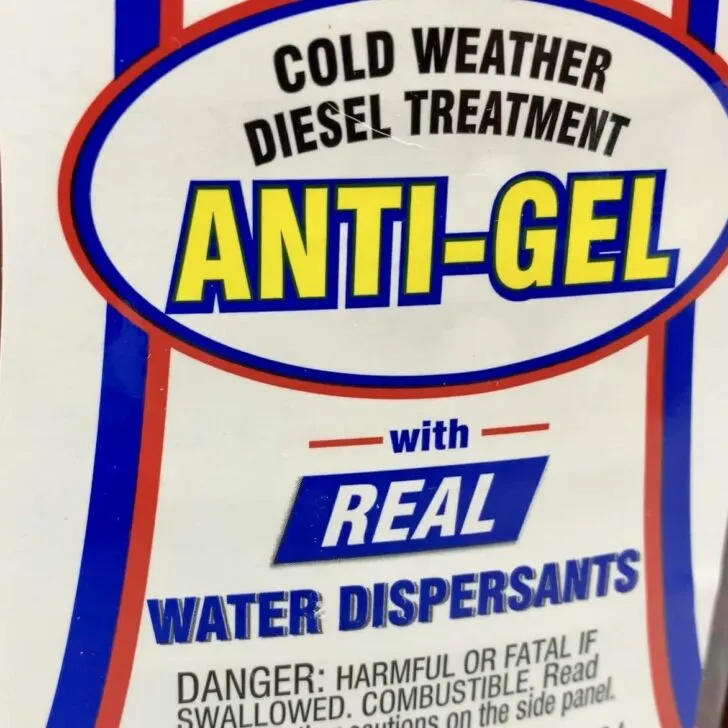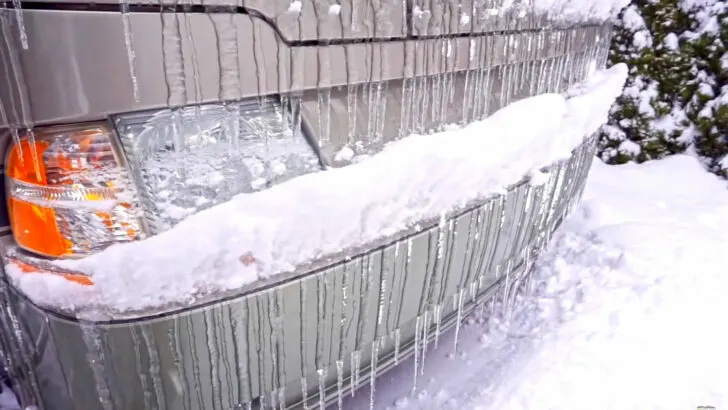We’re snowbirds, which means we usually head south for the winter. But we do sometimes want to participate in winter activities, or visit friends who live in places where temperatures can drop below freezing. Since RVing in the winter requires some special preparation, watch the video above (or keep reading below) where we share some of the tips we’ve learned over the years to make winter RVing trips as successful as possible!
Add Anti-Gel Additive to Diesel RVs
First, before traveling to colder weather, add an anti-gel additive to the fuel tank of diesel RVs. This helps ensure you don’t get stranded. The additive will prevent your fuel from gelling in freezing weather.

Look for “Anti-Gel” on the label
Any good quality anti-gel additive will do the trick (we usually get Power Service Diesel Fuel Supplement at Walmart… but couldn’t find it this time and used Howes Diesel Treat instead because it was available). You need to add the anti-gel additive to the fuel tank, using a funnel, before you add the fuel. That way, when you add the fuel, it will mix in with the additive. If you don’t take this precautionary step, you could get stuck until the weather warms up!
Another thing you need to do is ensure the fuel with the additive mixed in gets into all your fuel lines. That means you can’t just add the anti-gel additive to the tank and be protected. You need to run the RV’s engine for a bit after adding the anti-gelling agent to the fuel. Also, be sure to run your diesel generator, as it uses the same fuel source as your engine. That will draw the treated diesel through the fuel lines and into the generator. Once you’ve completed these steps, you can have confidence knowing that your RV’s engine and generator are ready to take on the coldest of weather.
Avoid Freezing Your Freshwater Hose
When you visit a freezing climate for a short amount of time, the best way to avoid a frozen water hose is to fill your freshwater tank, then disconnect your water hose and store it back inside. Rather than staying connected to the water source, you’ll fill your tank and then use that on-board water supply for the duration of your stay. You can of course re-fill the freshwater tank as needed. For longer (or more frequent) stays of winter RVing, you’ll want to invest in a heated water hose to fight the cold. Or, you can make your own by using heat tape and split foam tubing.
Don’t forget… even though you’re just filling your freshwater tank, be sure to use your pressure regulator to avoid damaging your water lines.
Avoid Freezing Your RV Sewer Hose
Accidentally freezing your water hose is one thing, but no one wants to deal with a frozen sewer hose! ? There are two options to avoid a frozen sewer hose.
-
Add a Sewer Hose Support
One way to make winter RVing a more pleasant experience is to use a sewer hose support (we actually use one 100% of the time, and some places even require them). You need to make sure you have a downhill flow from the RV to the sewer connection. In freezing temperatures, letting your sewer hose lie flat on the ground is a recipe for disaster. The downhill slope makes sure you won’t have any water sitting in your sewer hose that will freeze and block things up. The best thing to do is to close your grey valve (the black valve MUST be kept closed 100% of the time, anyway) and only dump every few days as needed, just like when you’re boondocking.
-
Leave Your Sewer Hose Stowed
If a sewer hose support doesn’t allow you to have the needed downhill slope to the sewer connection, you may have to leave your hose stowed while you’re parked. In this situation, you’ll only connect your hose when you need to dump your tanks, then return it to its storage location.
Avoid Freezing Your RV’s Plumbing
When you’re winter RVing, below are some steps you can take to keep your basement and plumbing from freezing. It’s important to keep your basement area warm in cold climates, as frozen pipes can cause damage to your RV… in the form of a flood!

Don’t get caught unprepared for cold weather!
Put a 60W Lightbulb in the Basement
Many RVs use the onboard furnace to heat the basement, and therefore the water compartment and pipes. But the furnace is the single biggest propane draw in just about any rig. By installing a 60W incandescent light bulb in your basement (we use a drop light), you can save on propane by using other sources of heat (electric space heater(s), or a portable propane heater, which is much more frugal on propane use than a typical RV furnace) and not running the furnace any more than necessary… or at all… while ensuring your plumbing won’t freeze. Even though one light bulb doesn’t seem like it would be effective in your RV basement, it gives off a surprising amount of heat, easily enough to keep things from freezing.
Plug Any Additional Openings
Another step to take to help seal your basement from the cold is to seal up any openings. You can stuff a cloth into open spots, such as the sewer hose opening. The cloth provides some additional insulation by stopping cold air from blowing in. By blocking off any additional openings, you’re helping the heat from the 60W lightbulb to keep the area warm.
Use A Remote Temperature Sensor
An additional way to add peace of mind when winter RVing is to place a remote temperature sensor in your basement. This sensor lets you keep track of the exact temperature in your basement without even having to go outside. If your basement temperature drops into the mid- to upper 30’s °F, you should turn on your furnace to prevent freezing, since that means it’s so cold outside that the light bulb can’t keep up. Preventing your plumbing from freezing is far more important than conserving propane!
Watch Tire Pressures in Cold Weather
When you’re in cold climates, your tire pressures will drop considerably. This means you risk running them well below the recommended and safe PSI if you don’t add additional air prior to travel.
While you could inflate your tires the morning you plan to travel, doing it ahead of time can prevent you from having to deal with it during the coldest time of day, which is first thing in the morning. When we see the temperature for our planned travel day is forecast to plummet, we figure it’s better to take care of this task ahead of time. By adding 5-10 PSI before it gets really cold, in the worst case scenario, you might just need to let a little air out to fine tune the pressures before departing. Since it’s much quicker to let air out of your tires than it is to add it, this will save time on the morning of your road trip… and avoid the need to spend more time outside than necessary during the coldest weather.
This is where carrying a reliable portable air compressor is essential, and we never travel without one. It’s also important to note here that your cold inflation pressure should never exceed the maximum PSI as listed on the tire sidewall.
NOTE: Get a Viair high-quality, high-pressure compressor from MobileMustHave.com and save 5% using Discount Code “RVGEEKS“:
Thanks to the latest additions to our RV internet arsenal from MobileMustHave, we're able to stay connected more reliably... and more remotely... than we ever could before. We couldn't be happier...Show More
Thanks to the latest additions to our RV internet arsenal from MobileMustHave, we're able to stay connected more reliably... and more remotely... than we ever could before. We couldn't be happier with the equipment we now have!
Upgrade your RV internet connectivity with great products from Peplink, WeBoost, Parsec, Poynting, Mobile Mark, and more. And while you're there, look at other great products like Viair Compressors!
Watch our video about our RV internet connectivity solutions for 2021
Save 5% on your equipment order at MobileMustHave.com when you click the button on this deal or use discount code "RVGEEKS" at checkout!
Show LessTurn Your Block Heater On The Night Before Travel
If your engine is equipped with a block heater, turn it on the night before you leave for a trip when RVing in winter climate. This makes the engine easier to start, allowing for a smoother departure when you’re ready to hit the road. It’s also better for the long-term health of your engine to pre-warm it before starting on very cold days.
Connect External Propane for Extended Winter RVing
When you spend long periods of time winter RVing, an external propane tank makes the stay warmer and less of a hassle. You can connect to an external tank to give you enough propane for an extended stay without having to drive your RV somewhere to refill your onboard/portable propane tank(s). Be sure to watch our video showing you how to connect your RV to an external propane tank for details.
Featured & Related Products:
- Power Service Diesel Fuel Supplement is what we normally use
- Howes Diesel Treat is what we used in the video because it was available
- 120V Drop Light
- 60W Incandescent Bulb, Rough Service (6-pack… share ’em with friends… or keep the extras, they’ll be worth something some day ? )
- Water Hose Heat Tape
- Heated Drinking Water Hose
- Slunky Sewer Hose Support
- Adjustable Water Pressure Regulator
- Kozy World Vent-Free Infrared Propane Heater
- Kozy World Heater Feet Kit
- Indoor/Outdoor Temperature Sensor
- Viair 400P-RV Air Compressor (on Amazon)
- Viair Compressors (at MobileMustHave.com – Save 5% with Discount Code THERVGEEKS)
- Accutire Digital Tire Pressure Gauge



Drew
Saturday 12th of December 2020
Luckily it doesn't freeze long enough here for anything to happen. Jusy fyi- in Ca. you can't buy incandescent lights anymore. Thanks for the article guys!
Drew
TheRVgeeks
Saturday 12th of December 2020
LOL, Drew! Staying where it's above freezing is definitely our preferred technique. ? And there's still a small loophole for getting incandescent bulbs, even in Canada: rough service bulbs! Here's an Amazon.ca link to a 4-pack you can pick up today: https://www.amazon.ca/dp/B000BQ7WWC/ref=cm_sw_em_r_mt_dp_b2p1Fb2YESDJ1
Get 'em while you can! LOL!